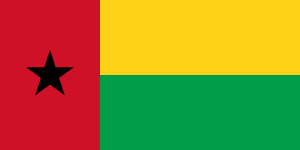
| Colors | HEX Code | RGB | CMYK |
|---|---|---|---|
| Red | #CE1126 | 206, 17, 38 | 0, 92, 82, 19 |
| Yellow | #FCD116 | 252, 209, 22 | 0, 17, 91, 1 |
| Green | #009E49 | 0, 158, 73 | 100, 0, 54, 38 |
| Black | #000000 | 0, 0, 0 | 0, 0, 0, 100 |
The flag of Guinea Bissau has the Pan-African colors, arranged as a vertical red stripe on the hoist side with a black star on it. Yellow and green equal horizontal stripes are found on the outer side of the flag.
Meaning of the Flag of Guinea-Bissau
Red symbolizes the struggle and blood that is shed for independence, while yellow symbolizes mineral wealth and the Savannas. Green denotes the natural resources, particularly forests. The black star stands for African unity and determination to live in dignity.
History of the Guinea-Bissau Flag
Guinea-Bissau was a Portuguese colony. It launched the movement against colonization, like many African colonies that were seeking independence, and discussing the start of the West African Lands Federation. The flag is based on that of the African Party for the Independence of Guinea and Cape Verde (PAIGC), which led the independence struggle since the 1960s. Countries like Ghana and Guinea adopted the Pan-African colors in their flags. Inspired by the neighboring countries’ flags, especially Ghana, the colors on the Guinea-Bissau flag were chosen to be red, yellow, and green. The star was added to represent the unity of the African people, and their right to live freely. After 11 years of armed conflict, Guinea Bissau finally proclaimed full independence in 1974.The flag, however, was raised in 1973, before Portugal recognized the country’s independence and flag.